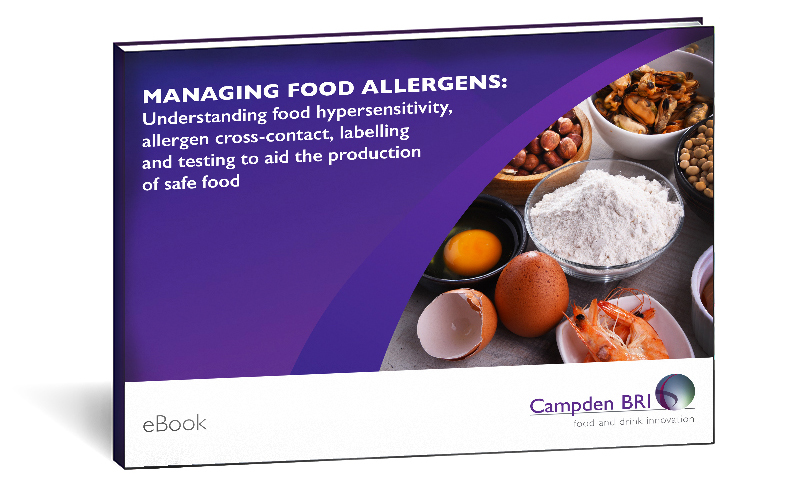
Frequently answered questions about EU-harmonised and UK food law
4 August 2023 | Lewis Wallis, Regulatory Affairs Advisor and Dr Helen Arrowsmith, Regulatory Affairs Manager and Allergen Specialist
Product labelling and compliance with relevant EU-harmonised and UK legislation
Our experienced team of regulatory experts can help you ensure that your products are compliant with the legislative requirements of your target market. We offer a valuable, extensive and authoritative information and advisory service to help clients stay compliant with food legislation in more than 80 countries.
The Campden BRI Global Regulatory Affairs Team are always busy on many fronts; as well as delivering training courses, conducting label reviews and being involved with projects for our clients (such as horizon scanning and market entry requirements), we also answer enquiries from both Campden BRI members and other clients. Those regulatory advisers dealing with EU-harmonised and UK legislation are continuing to keep up to speed with the numerous developments leading to further divergence between these regulatory regimes post-EU Exit. The most frequently asked questions however, are not in areas impacted by the UK leaving the EU.
The most common enquiries submitted to our EU-harmonised/UK Regulatory Affairs team concern the provision of food information on the labels of prepacked food and drink products and, in particular, the requirements for the naming of products, allergen labelling and ingredient listing. To help with your understanding on these topics, we have compiled some key information for you to consider, to help ensure that your labels are legally compliant with relevant EU-harmonised and UK legislation.
Regulation (EU) No. 1169/2011, as amended, is the foundation for the provision of food information to consumers (FIC) in the EU and has been retained into UK law post-EU Exit; it lays down the specific information that should feature on every food label (FIC Articles 9 and 10), although some exemptions apply.
1. Product names
The first piece of mandatory information required by the FIC is the name of the product, which is arguably one of the most important details for helping a consumer to identify the product and decide whether to buy it. As with all food information, the name of a product must not be misleading (FIC Article 7).
To fulfil the requirement to provide a legally compliant name for a food product one of three types of name must be on the label:
- Legal name – the name prescribed by legislation that specifically describes the compositional criteria of certain products that must be named as such (for example, milk chocolate, fruit juices, extra virgin olive oil, instant coffee). If a legal name exists, then this must be included on the label of the product. In the absence of a specific legal name laid down in legislation, an appropriate customary name or descriptive name is required.
- Customary name – a name that is widely understood and accepted by consumers in the country of sale, without the need for further explanation (a UK example is ‘Yorkshire pudding’).
- Descriptive name – a name that provides a description of the food and, if necessary, its use, which enables consumers to understand the ‘true nature’ of the product and to distinguish it from other products with which it might be confused. ‘True nature’ means a clear and accurate description of the characteristics of the food, including those ingredients that characterise the food. An example of a descriptive name for a vegetable pizza, for example, could be: ‘A thin and crispy pizza base topped with tomato sauce, mozzarella cheese, courgettes, red and yellow peppers and red onions.’
Brief, marketing-driven names (so-called ‘fancy names’), brand names and proprietary names will not, on their own, satisfy the product naming requirement. A trade-mark or brand name cannot substitute for a legally compliant name of the food.
A question often asked about naming food is whether the order of the ingredients within the descriptive name needs to match the order of those ingredients within the list of ingredients. For the majority of foods (excluding fruit juices) the answer is no. The legislation does not require that the name of the food be determined according to the quantity of ingredients used in a recipe. Instead, the name can be established dependent on the relative extent to which particular ingredient(s) characterise the finished product. Therefore, we often use examples such as ‘garlic bread’ or ‘cheese and potato pie’, in which the characterising / value-added ingredient is given first in the name of the food, even though it is present at a lower level than other ingredients mentioned in the product name; this is legally acceptable.
2. Allergen labelling
The FIC requires specific listed substances and products (see Annex II), which are known to cause allergies or intolerances and are intentionally present in the finished product (even in an altered form), to be clearly designated. These substances must be emphasised in the ingredients list or included in a ‘contains’ statement where there is no ingredients list; please note that some exemptions apply (also see FIC Annex II). Where the name of the food clearly relates to the substance or product, a separate indication is not required, for example, single-ingredient foods such as a carton of milk.
Download our FREE Managing Food Allergens eBook today! Secure food safety, control and confidence through effective allergen management

Information on the presence of these substances must also be provided for non-prepacked food (for example, food sold loose, and meals served in a restaurant). It is not required for the business to provide a full ingredient list, but the allergen information must be communicated, either in writing, orally or by signposting the customer to an appropriate source.
Another category of food for which allergen information is required is that which is prepacked for direct sale (PPDS), essentially food packaged at the same place it is sold to consumers. In the UK, such products must now also be labelled with the product name and a full ingredient list, with all allergenic ingredients emphasised.
Precautionary allergen labelling
Regarding precautionary allergen labelling (PAL), which relates to the unintentional presence of the FIC Annex II substances due to cross-contact, there is no specific legal requirement to use such warnings to indicate possible allergen cross-contact. The decision as to whether to provide such information must be based on a meaningful risk assessment applied to a responsibly managed operation. For more information on PAL and developments in this area please see our blog.
Cereals containing gluten
One area we are frequently asked about is ‘cereals containing gluten’ and ‘gluten’. Gluten as such is not an allergen as listed in Annex II to the FIC; it is the listed cereal(s) containing gluten (that is, wheat, rye, barley, oats and their hybridised strains) that are subject to allergen labelling. ‘Cereals containing gluten’ are not one allergen group / entity and people may be allergic to one cereal but not another. The cereal sources must therefore be mentioned and emphasised in the ingredients list individually. Please refer to our blog on ‘cereals containing gluten’ and ‘gluten’ for further information.
3. Ingredient listing
It may sound obvious, but it is a legal requirement for all ingredient lists to begin with a suitable heading that includes the word ‘ingredients’. Although not all products require an ingredients list and specific exemptions are outlined in FIC Article 19.
We are regularly asked about the naming of ingredients. For the designation of the ingredients included in the product’s ingredient listing, the same rules outlined in our first section on naming applies. Where there is an existing legal name for ingredients that meet particular compositional criteria (for example, glucose syrup and casein), this should be used. In the absence of set legal terminology, a customary name or a descriptive name is required. As already stated, ‘fancy’, brand and proprietary names cannot replace the legally compliant, neither can they be used as ingredient designations.
Other legislation may also need to be consulted when forming a compliant ingredient listing, particularly if you are using additives, enzymes or flavourings in the final product.
Our Global Regulatory Affairs team can advise on other topics and markets
The above information does not cover all considerations and requirements relating to these aspects of product labelling; if you would like a full label review from our regulatory experts to check the compliance of your products across UK/EU and Global markets, or if you would like to ask specific questions about labelling requirements or any aspect of food law, please reach out to us via regulatoryadvice@campdenbri.co.uk
Alternatively, for more information on the topic areas above, and the many other necessary considerations when producing legally compliant products, check out our training courses covering food and drink labelling across a range of markets including EU/UK, US, China, GCC, Australia and New Zealand.
Frequently answered questions about EU-harmonised and UK food law
Click below to download a copy of the white paper in PDF format
Managing Food Allergens eBook
Download our FREE Managing Food Allergens eBook today! Secure food safety, control and confidence through effective allergen management.






